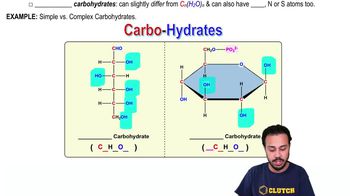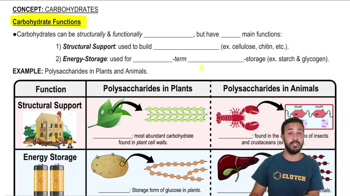Table of contents
- 1. Introduction to Biology2h 42m
- 2. Chemistry3h 40m
- 3. Water1h 26m
- 4. Biomolecules2h 23m
- 5. Cell Components2h 26m
- 6. The Membrane2h 31m
- 7. Energy and Metabolism2h 0m
- 8. Respiration2h 40m
- 9. Photosynthesis2h 49m
- 10. Cell Signaling59m
- 11. Cell Division2h 47m
- 12. Meiosis2h 0m
- 13. Mendelian Genetics4h 44m
- Introduction to Mendel's Experiments7m
- Genotype vs. Phenotype17m
- Punnett Squares13m
- Mendel's Experiments26m
- Mendel's Laws18m
- Monohybrid Crosses19m
- Test Crosses14m
- Dihybrid Crosses20m
- Punnett Square Probability26m
- Incomplete Dominance vs. Codominance20m
- Epistasis7m
- Non-Mendelian Genetics12m
- Pedigrees6m
- Autosomal Inheritance21m
- Sex-Linked Inheritance43m
- X-Inactivation9m
- 14. DNA Synthesis2h 27m
- 15. Gene Expression3h 20m
- 16. Regulation of Expression3h 31m
- Introduction to Regulation of Gene Expression13m
- Prokaryotic Gene Regulation via Operons27m
- The Lac Operon21m
- Glucose's Impact on Lac Operon25m
- The Trp Operon20m
- Review of the Lac Operon & Trp Operon11m
- Introduction to Eukaryotic Gene Regulation9m
- Eukaryotic Chromatin Modifications16m
- Eukaryotic Transcriptional Control22m
- Eukaryotic Post-Transcriptional Regulation28m
- Eukaryotic Post-Translational Regulation13m
- 17. Viruses37m
- 18. Biotechnology2h 58m
- 19. Genomics17m
- 20. Development1h 5m
- 21. Evolution3h 1m
- 22. Evolution of Populations3h 52m
- 23. Speciation1h 37m
- 24. History of Life on Earth2h 6m
- 25. Phylogeny2h 31m
- 26. Prokaryotes4h 59m
- 27. Protists1h 12m
- 28. Plants1h 22m
- 29. Fungi36m
- 30. Overview of Animals34m
- 31. Invertebrates1h 2m
- 32. Vertebrates50m
- 33. Plant Anatomy1h 3m
- 34. Vascular Plant Transport1h 2m
- 35. Soil37m
- 36. Plant Reproduction47m
- 37. Plant Sensation and Response1h 9m
- 38. Animal Form and Function1h 19m
- 39. Digestive System1h 10m
- 40. Circulatory System1h 57m
- 41. Immune System1h 12m
- 42. Osmoregulation and Excretion50m
- 43. Endocrine System1h 4m
- 44. Animal Reproduction1h 2m
- 45. Nervous System1h 55m
- 46. Sensory Systems46m
- 47. Muscle Systems23m
- 48. Ecology3h 11m
- Introduction to Ecology20m
- Biogeography14m
- Earth's Climate Patterns50m
- Introduction to Terrestrial Biomes10m
- Terrestrial Biomes: Near Equator13m
- Terrestrial Biomes: Temperate Regions10m
- Terrestrial Biomes: Northern Regions15m
- Introduction to Aquatic Biomes27m
- Freshwater Aquatic Biomes14m
- Marine Aquatic Biomes13m
- 49. Animal Behavior28m
- 50. Population Ecology3h 41m
- Introduction to Population Ecology28m
- Population Sampling Methods23m
- Life History12m
- Population Demography17m
- Factors Limiting Population Growth14m
- Introduction to Population Growth Models22m
- Linear Population Growth6m
- Exponential Population Growth29m
- Logistic Population Growth32m
- r/K Selection10m
- The Human Population22m
- 51. Community Ecology2h 46m
- Introduction to Community Ecology2m
- Introduction to Community Interactions9m
- Community Interactions: Competition (-/-)38m
- Community Interactions: Exploitation (+/-)23m
- Community Interactions: Mutualism (+/+) & Commensalism (+/0)9m
- Community Structure35m
- Community Dynamics26m
- Geographic Impact on Communities21m
- 52. Ecosystems2h 36m
- 53. Conservation Biology24m
4. Biomolecules
Carbohydrates
Problem 5`
Textbook Question
Choose the term that correctly describes the relationship between these two sugar molecules:

a. Structural isomers
b. Cis-trans isomers
c. Enantiomers
d. Isotopes
 Verified step by step guidance
Verified step by step guidance1
Step 1: Begin by understanding the definitions of each term provided in the options. Structural isomers are molecules with the same molecular formula but different structural arrangements. Cis-trans isomers are a type of stereoisomerism where the same atoms are connected differently in space due to the presence of double bonds. Enantiomers are molecules that are mirror images of each other and cannot be superimposed. Isotopes are variants of a particular chemical element that differ in neutron number.
Step 2: Examine the sugar molecules in question. Look for differences in their structural arrangement, spatial orientation, or atomic composition. This will help you determine which type of isomerism or relationship they exhibit.
Step 3: Compare the molecular formulas of the two sugar molecules. If they have the same molecular formula but differ in structure, they might be structural isomers.
Step 4: Check for any double bonds in the sugar molecules. If present, analyze the spatial arrangement around these bonds to determine if they are cis-trans isomers.
Step 5: Consider the possibility of enantiomers by checking if the molecules are non-superimposable mirror images of each other. If the molecules differ in neutron number, they might be isotopes, but this is less likely for sugar molecules.
 Verified video answer for a similar problem:
Verified video answer for a similar problem:This video solution was recommended by our tutors as helpful for the problem above
Video duration:
3mPlay a video:
Was this helpful?
Key Concepts
Here are the essential concepts you must grasp in order to answer the question correctly.
Structural Isomers
Structural isomers are molecules with the same molecular formula but different structural arrangements of atoms. This means they have different physical and chemical properties despite having the same number of each type of atom. Understanding structural isomers is crucial for identifying differences in molecular structure that affect function.
Recommended video:
Guided course

Community Structure
Cis-Trans Isomers
Cis-trans isomers, also known as geometric isomers, occur due to the restricted rotation around a double bond or a ring structure. In these isomers, the same atoms or groups are positioned differently in space, either on the same side (cis) or opposite sides (trans) of the bond or ring, affecting the molecule's properties and reactivity.
Recommended video:
Guided course

Golgi Apparatus
Enantiomers
Enantiomers are a type of stereoisomer where molecules are mirror images of each other but cannot be superimposed. They have identical physical properties except for their interaction with polarized light and reactions in chiral environments. Enantiomers are important in biology because they can have drastically different effects in biological systems.
Related Videos
Related Practice
















